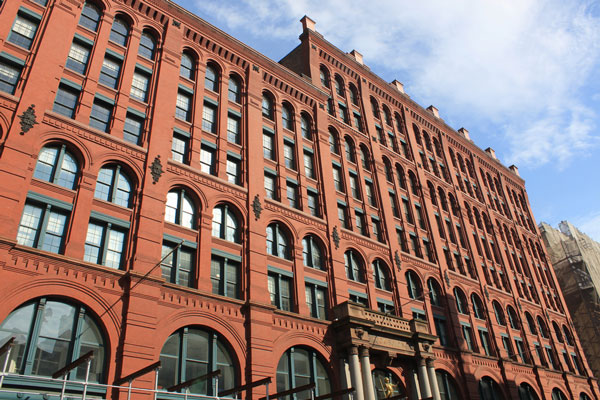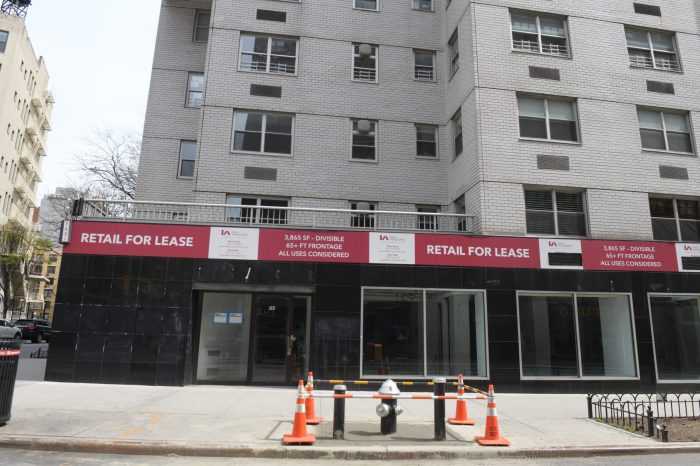
At the same time, the commission conferred landmark designation on the former R.H. Macy annex at 56 W. 14th St. in the original Ladies’ Mile department store district, and the 1894 Mutual Reserve Building at 305 Broadway at Duane St. in the Civic Center area.
The commission unanimously approved the proposed penthouse to the Puck Building, at Lafayette and Houston Sts., after the owner, Jared Kushner, revised the plans several times after four rejections by the commission since August.
As finally approved, the proposed penthouse on the landmarked Puck Building has been reduced by 1,500 square feet and is 20 feet shorter than originally proposed.
“They’ve reached the target of minimalism in terms of massing,” said Michael Devonshire, an L.P.C. commissioner, at the agency’s Dec. 20 meeting.
The original plan called for a penthouse of glass and metal that would have been prominently visible for several blocks north, east and west of the building at 295 Lafayette St.
In the new plans, much of the penthouse would be virtually invisible from the west. Moreover, the materials have been changed to masonry and brick in the approved plan, more closely matching the facades of the seven- and eight-story building erected in two phases between 1885 and 1893.
“We don’t want to ignore the fact that this building has evolved in its lifetime. It’s not our job to stop that evolution,” said Elizabeth Ryan, another L.P.C. commissioner.
Cas Stachelberg, of Higgins and Quasebarth, architect of the revised plan, noted that the project includes restoration of the original crenellation of the original sections of the building.
Designed by Albert Wagner, the front of the building on Lafayette St. — then known as Elm St. — was relocated in 1899 when the street was widened. The building sports two gilded statues, by the sculptor Henry Baerer, of Puck, a character from Shakespeare’s “A Midsummer’s Night Dream” — one on the building’s northeast corner of Houston and Mulberry Sts., the other over the main entrance on Lafayette St. The building was originally the home of Ottman Lithographing Company and Puck Magazine, the humor magazine that ceased publication in 1918.
Andrew Berman, executive director of the Greenwich Village Society for Historic Preservation, who opposed the earlier proposals for the penthouse addition, said, “We are very glad the Landmarks Preservation Commission listened to calls to reject prior versions which would have overwhelmed and fundamentally changed one of our city’s most iconic and beloved landmarks. Only time will tell if the final scaled-back version is truly worthy of a great New York landmark.”
Kushner, a developer who also owns the New York Observer, said he was pleased with the approval.
“The final result will enable us to build a spectacular addition, which is very much in line with the very special and unique character of the building,” he said.
Although no construction schedule was made public, the plan calls for the top floors and the penthouse to become six residential condos, ranging in price from $15 million to $50 million.
The newly designated Macy’s 14th St. landmark is a slender nine-story building completed in 1897. It was the last phase of the expansion of the famed department store that dominated Sixth Avenue at 14th St. from its founding in 1858 until 1902 when it moved to Herald Square.
The Beaux Arts-style, limestone-clad building was designed by William Schickel and Isaac Edward Ditmars. After Macy’s moved uptown, the building was part of another department store until 1914, and from 1938 to 1965 it was the home of Norma Lites, one of the largest manufacturers of Christmas tree lights.
The newly designated 13-story Mutual Reserve Building on Broadway at Duane St., designed by William H. Hume, is one of the earliest steel cage-framed buildings that were precursors of skyscrapers. The first tenant was Mutual Reserve Fund Life Association, an insurance company that went out of business in 1909. At the turn of the 20th century, that part of Broadway included the front office of the 1894 Home Life Insurance building at 256 Broadway, designed by Napoleon le Brun & Sons, and New York Life Insurance at 346 Broadway, designed by Stephen Decatur Hatch with McKim, Mead & White. Both buildings are designated landmarks.

















